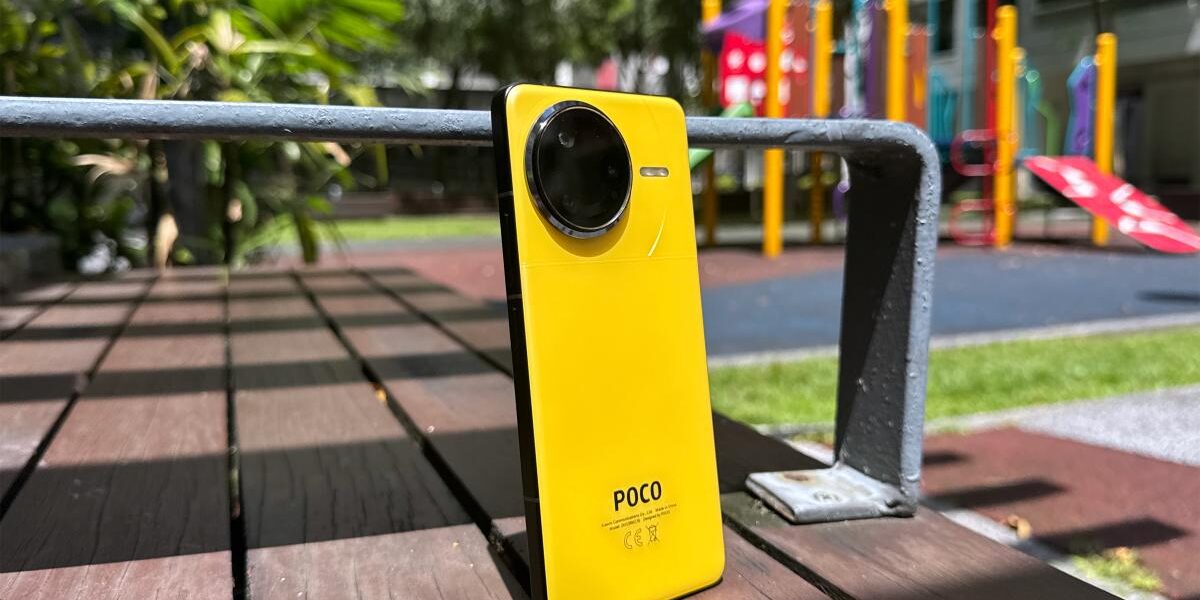Poco F7 Ultra phone review: There’s been a murder, a flagship killer was here

A yellow hitman, going at a low price of S$869
Poco may not be as famous as its parent brand, Xiaomi, but Poco phones are popular amongst a keen crowd that chases phones with high-end components at affordable prices. To reward its fans and convert new users to its brand, Poco now has a super-high-end model, the Poco F7 Ultra.
For those unfamiliar, Poco’s F-series is already the brand’s highest-end product range. The “F7” naming marks its 2025 update. As its name implies, the Ultra is the best possible variant of them all. Yet, Poco only asks for S$869 (256GB) and S$929 (512GB) in return.
TL;DR version: A true flagship killer emerges, but even the best flagships do not waver in the face of death.
Buy one at Xiaomi’s official online store, the Lazada platform, and the Shopee storefront.
Don’t let the prices fool you. It contains a Qualcomm Snapdragon 8 Elite chipset like the ones inside Honor Magic7 Pro (S$1,399 for 512GB), Samsung Galaxy S25 Ultra (S$1,828 for 256GB), and Xiaomi 15 Ultra (S$1,699 for 512GB). Poco omitted an entire digit from its price tag because it’s designed as a “flagship killer”, a phone enthusiast’s slang for flagship quality at lower prices.
Ensuring that dominance is a string of no-nonsense specs and components. Poco F7 Ultra gets a 5,300mAh battery, 120W wired charging, 50W wireless charging, a display capable of 120Hz refresh rate (that even has an extra graphics chipset, VisionBoost D7), LPDDR5X RAM, UFS 4.1 storage, and an IP68 resistance rating against water and dust. If you’ve been staying abreast of flagship phone updates, you’d also know there’s enough crammed in to qualify the Poco F7 Ultra as a high-end device.
The software isn’t shabby either, since it runs on Xiaomi HyperOS 2, which is also found on the Xiaomi 15 Ultra. It even has Google’s phone AI, Gemini, pre-installed as an app and hard-coded into its power button.

In our previous hands-on, we learnt that its photography is better than we expected, even if it’s not at the same level as the phones it wants to beat. Here, we determine whether the rest of the phone can hold up just as well. Is it really a flagship killer or just another budget flagship alternative?
Let’s find out.
|
Poco F7 Ultra |
|

|
|
| Launch SRP | |
|---|---|
| Operating system | |
| Processor |
|
| Built-in Memory | |
| Display |
|
| Camera |
|
| Connectivity |
|
| Storage Type |
|
| Battery |
|
| Dimensions | |
| Weight |
Looks do matter

Like its past flagship products, the Poco F7 Ultra uses colour as a language to inform its design choices. The striking Yellow returns, alongside a more muted Black. That said, the design tidbits on our Yellow Poco F7 Ultra showed it has received careful craftsmanship, unlike other cookie-cutter Chinese-made Android handsets.

For example, it houses all its rear cameras on a glass island, but Poco has shaped it into a timeless watch face with its chamfered rim. The slanted and layered design also does a great job hiding the cameras’ bulk.

The edges of the plastic rear plate are bevelled to help with grip and to give the phone a softer, friendlier look. This elevates the Poco F7 Ultra’s appeal beyond simply a phone to get things done.

Another careful detail is how the phone’s black-lined sides are very similar (if not identical) in colour to its accents (the camera housing, the Poco logo, and the front screen’s super-thin bezels). Consistency is really challenging, especially when phones are typically made from many different materials (and many different textures).
Topping it off is a deliberate two-tone rear design that employs two different polishes to accentuate its flagship positioning.

The best way to summarise its design sense is that the Poco F7 Ultra looks nothing like a forgotten midrange or flagship-lite phone, even if you’re not a fan of its gaudy brand colours. It costs half its main rivals, yet no discounts were given for its design process.
If Yellow is not your favourite colour, there’s always a Black variant with a subtle orange camera ring. You still get to enjoy the rest of this very practical and cleverly designed mobile phone. Choosing either comes down to personal preference.

While its 6.67-inch Flow AMOLED panel gives off a transparent plastic vibe (likely because of their Poco Shield Glass), it’s not any less capable than some premium handsets out there.
The display settings let you fully use its 3,200 x 1,440 pixels resolution and max out its 120Hz refresh rate on supported apps. Your content will also show up with 12-bit colour depth, supporting HDR10+ and Dolby Vision.
Whether you’re an avid gamer fluent with every Southeast Asian slur, a content demon feeding off YouTube/Netflix, or are chronically online on popular social media apps, the Poco F7 Ultra’s viewing experience would not fall short in any of those activities. The display is generally pleasant for viewing and reasonably responsive to gaming input (thanks to its 480Hz touch sampling rate and 2,560Hz “instant touch sampling rate” in Game Turbo mode).
You might think that smooth frames and high resolution are just nice-to-have perks for a casual phone user, but folks who choose Poco F7 Ultra for its provision of low-price-and-high-specs would want these optimisations available, and it’s done well on this device.

The only quirk we encountered was its dimming controls. Using a third-party light meter to monitor its brightness, we realised that the screen always outputs slightly lower luminance (nits/cdm2) after we lift our finger from the controls. Perhaps the inch-long brightness bar is not enough to capture its extremely granular steps of control (up to 1,800-nits HBM brightness and 3,840Hz PWM dimming), or we fat-fingered the device unknowingly. Hopefully, Poco will fix this glitch soon.
The speakers, while sufficiently loud, were not anything to write home about.
A Xiaomi phone in disguise?

We don’t have overwhelmingly good or bad things to say about Poco F7 Ultra’s choice of user interface. It runs a mildly modified version of Xiaomi’s HyperOS 2, which is based on Android 15. If you’ve seen our Xiaomi 15 Ultra review, you’ve seen how the interface delivers on the basics. That also means you’re familiar with how the Poco F7 Ultra works.
The main user-facing difference is that the Poco phone uses round little logos for app icons, while Xiaomi 15 Ultra’s HyperOS 2 uses almost square blocks for Xiaomi’s app icons.

Happily, the phone keeps its bloatware and preinstalled apps under control. They’ve grouped system apps neatly into one folder, and commonly used third-party ones in another “more apps” container. Most third-party apps Poco F7 Ultra has, like Spotify and TikTok, would eventually see their way onto most users’ phones, so we’re not entirely against them.
First-party apps are mostly Xiaomi-branded, such as Mi Home for its smart home appliance controls and App Mall, which is Xiaomi’s app store. That’s fine by us, too.
The fact that it doesn’t have weird apps for games, livestreaming, or even personal loans is quite a fresh experience for users familiar with midrange devices stuffed full of that garbage.
There are pros and cons to the Poco F7 Ultra being so similar to a regular Xiaomi phone. It lacks its own software identity and design language, but we don’t think that’s more important than having an interface that’s tried, tested, clean, and familiar to users. That lets us move on to the real meat of Poco F7 Ultra, which is the imaging quality and whether it lives up to the benchmarks it promises.
Imaging Performance
Read our detailed imaging hands-on here.

Poco F7 Ultra comes with the following rear cameras:
- 50MP main camera: Light Fusion 800 image sensor, 2.0μm 4-in-1 Super Pixel (pixel-binning technique), 1/1.55-inch sensor size, f/1.6 aperture, 6P lens, OIS, 24mm focal length
- 50MP floating telephoto camera: f/2.0, OIS, 60mm focal length
- 32MP ultrawide camera: f/2.2 aperture, 120° field-of-view
As mentioned above, we had an in-depth hands-on photography experience, where we tried to get a sense of its photography chops across ~300 photos taken.
Our finding was that its imaging capabilities can punch above its weight class, and it’s more than sufficient for its asking price.
It’s surprisingly competent with sharpness and detail, even though it’s not near flagship devices which typically have better colours and handle exposure more correctly. Surprisingly, it has decent low-light performance—a common weak point with most non-flagship phones.
When compared to the Xiaomi 15 Ultra, it’s obvious that Xiaomi’s flagship, which has a larger sensor, has better clarity and detail. The Xiaomi phone also has more pleasant colours, even if its forced Leica filter might not be to everyone’s tastes.
Both Ultra phones clearly show that you get more out of your photos if you pay for the Xiaomi 15 Ultra. On the other hand, the Poco F7 Ultra is the alternative if you still want something with the same phone performance, Xiaomi-made, cheaper, and without the Leica filter. Poco’s Ultra is the closest we can get to a non-Leica-ed Xiaomi (albeit with lower clarity since it’s on a smaller sensor).
We’re just appending a few more photos below for your viewing pleasure, but you should check out the hands-on for a deeper understanding of what we think about the Poco F7 Ultra’s imaging capabilities.





Read our detailed imaging hands-on here.
Benchmark Performance
What drives the Poco F7 Ultra is the same flagship-grade 2025 chipset that pushes the limits of what today’s premium-grade phones offer. It’s none other than the Qualcomm Snapdragon 8 Elite. Poco even uses the full 8-core version, instead of the 7-core one seen on OPPO Find N5 (we learnt this by checking our core cluster readings seen inside our benchmarks).
To understand why this is a big deal, most premium phones carrying the same Qualcomm mobile platform typically cost around S$1,600—its main brand’s Xiaomi 15 Ultra itself is an excellent example at S$1,699 for 512GB storage. Costly premium phones like the Samsung Galaxy S25 Ultra can command S$1,828 for 256GB.
Poco F7 Ultra offers less in other areas, like imaging, in return for its performance. However, it also brought down its price to match.
We won’t want to bloat the comparison charts below with too many options, so we’ll only pick the Xiaomi 15 Ultra and Samsung Galaxy S25 Ultra as the flagship rivals. The rest will be against phones priced in the same bracket, like the Xiaomi 14T Pro.
Putting it to the test
To find out how the competitors line up specs and price-wise, check them out in this link.
To find out more about the tests we conduct and what they relate to, we’ve jotted them down here.




Benchmark Performance remarks
Because of its unique blend of price tag and true-flagship chipset, the Poco F7 Ultra’s performance-for-value proposition makes an excellent case study against many other alternatives in the same price range. We won’t deny many of the more expensive phones out there have better hardware or software polish, but not everyone sees the point in paying double for what’s available through Poco F7 Ultra.
From a synthetic benchmarking perspective, the only way to beat this phone is to have a Snapdragon 8 Elite device that’s even cheaper than its S$869 price tag.
Battery Life
Our battery benchmark uses PCMark for Android’s Work 3.0 Battery Life test to determine a modern Android-based smartphone’s battery uptime in minutes. This controlled benchmark simulates real-world usage with a combination of both web and social media browsing, video and photo editing, parsing data with various file formats, writing (on documents), and more.

The Poco F7 Ultra’s 5,300mAh silicon-carbon battery clocked in a little more than 12 and a half hours with the same battery benchmark tests. Anything above 12 hours is sufficient for most users (seeing how the test ends at the 20% battery mark), so you can expect the phone to last just as long as other leading mobile devices.
It’s more impressive when you realise that we set it to the maximum capability (1440p resolution and 120Hz refresh rate) as caveated in our testing remarks, so users who don’t max out the device might get even longer readings than ours.
With its included 120W wired charging adapter, the Poco F7 Ultra took about 30 minutes to go from 0% to 50% and 70 minutes to get a full 100% charge. This is normal performance for a Chinese Android flagship phone and consistent with its Xiaomi 15 Ultra brethren.
We did not test its 50W wireless charging, but it’s worth noting that it’s new to the Poco F series.
In all, we found nothing unusual or particularly notable about its battery uptime, other than the fact that it’s great and that it measures up very well against what’s out there.
Conclusion

Perhaps the title already gave it away, but Poco has rightfully earned that acclaim: Poco F7 Ultra is a clear flagship killer. It packs essential flagship components and works almost like one, but it only wants you to pay half of what it would have cost others.
Our only caveat is that the Poco F7 Ultra is not for everyone (but that’s true for any phone). Many users prioritise different needs, like owning known phone brands or having great photography. In contrast, others might believe a phone’s worth lies in its uptime, performance, and day-to-day use.
However, that’s exactly why the Poco F7 Ultra offers an interesting package. If you don’t care for brand names and don’t mind having decent but not mind-blowing photography, it’s hard to find another phone that covers it all for so little. It’s S$869 (256GB) for some of the best hardware today, and only S$929 (512GB) for double the storage—you can get two Poco F7 Ultras for the same price as a single Samsung Galaxy S25 Ultra (S$1,828 for 256GB).
If you feel safer with known brands like its parent Xiaomi, rival OPPO, or foreign contenders like Samsung, there’s not much we can say to convince you that the Poco F7 Ultra has better value. Neither would you care if polish matters more than cramming tons of perks in under a thousand bucks. We don’t blame you, either. Those rivals didn’t stick around this long because of luck or chance.

As far as performance goes, the Poco F7 Ultra does even better than the usual flagship-lite suspects that dominate this price range. It assassinates the parent Xiaomi 14T Pro (S$799 for 256GB), slits through the OPPO Reno13 Pro (S$999 for 512GB) effortlessly, and even true flagships like Samsung Galaxy S25 (S$1,288 for 256GB) will need to keep an eye open while it sleeps.
The real murder mystery? We still can’t figure out how or why it only costs S$869 (256GB). Maybe they saved a bit of money by reusing Xiaomi’s interface with a lower-quality camera set, but surely, the price difference shouldn’t be so drastic, right?
We think this phone is an excellent starting point as a premium flagship device for young people who don’t understand why other Singaporeans pay through their noses for highly-priced Android phones. Get one and you can decide if premium phones are worth your while. Even if you’re not that young anymore, it’s still a great alternative thanks to its cold-blooded flourish, at half the price.

Note: Poco F7 Ultra retails for S$869 (256GB) onwards at Xiaomi’s official online store, the Lazada platform, and the Shopee storefront.




